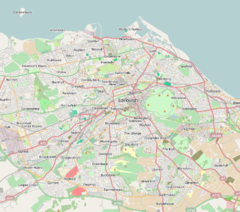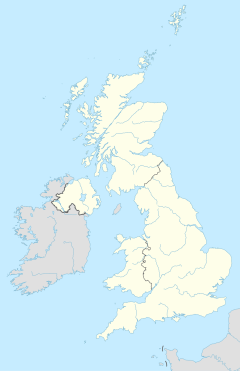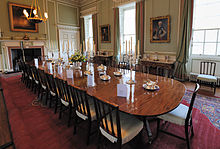Holyrood Palace
| Palace of Holyroodhouse | |
|---|---|
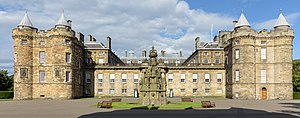 The Palace of Holyroodhouse viewed from the Forecourt | |
| General information | |
| Type | Official residence |
| Architectural style | Classical |
| Location | Royal Mile, Edinburgh, Scotland |
| Coordinates | 55°57′09″N 3°10′21″W / 55.95250°N 3.17250°W |
| Construction started | 1671 (north-west tower, 1528) |
| Completed | 1678 (north-west tower, 1536) |
| Owner | King Charles III in right of the Crown |
The Palace of Holyroodhouse (
The Palace adjoins Holyrood Abbey, and the gardens are set within Holyrood Park. The King's Gallery was converted from existing buildings at the western entrance to the Palace and was opened in 2002 to exhibit works of art from the Royal Collection.
King Charles III spends one week in residence at Holyroodhouse at the beginning of summer, where he carries out a range of official engagements and ceremonies. The 16th-century historic apartments of Mary, Queen of Scots, and the State Apartments, used for official and state entertaining, are open to the public throughout the year, except when members of the royal family are in residence. The Palace also serves as the official residence of the Lord High Commissioner to the General Assembly of the Church of Scotland during the annual meeting of the General Assembly.
History
12th–15th centuries

The ruined Augustinian Holyrood Abbey that stands next to the Palace of Holyroodhouse was founded in 1128 at the order of King David I. The name derives either from a legendary vision of the cross witnessed by David I, or from a relic of the True Cross known as the Holy Rood or Black Rood, and which had belonged to Saint Margaret, David's mother.[2] As a royal foundation, and sited close to Edinburgh Castle, it became an important administrative centre. A Papal legate was received here in 1177, while in 1189 a council of nobles met to discuss a ransom for the captive William the Lion.[3] The Parliament of Scotland met at the abbey seven times between 1256 and 1410, and in 1328 the Treaty of Edinburgh–Northampton was signed by Robert the Bruce in the 'King's Chamber' at the abbey, indicating that it may already have been in use as a royal residence. In 1371, David II became the first of several kings to be buried at Holyrood Abbey, and James II was born, crowned, married, and buried there.[3] James III and Margaret of Denmark were married at Holyrood in 1469.[2] The early royal residence was in the abbey guesthouse, and by the later 15th century the king occupied dedicated royal lodgings.[3][2]
16th century
Between 1501 and 1505,
James V added to the palace between 1528 and 1536, beginning with the present James V's Tower, which is the oldest surviving part of the palace.[9] This huge rectangular tower, rounded at the corners, provided new royal lodgings at the north-west corner of the palace. Originally equipped with a drawbridge leading to the main entrance (protected with a yett) on the first floor, it may also have been protected by a moat, and provided a high degree of security. The south range was remodelled, and the old queen's apartments were converted into a new chapel, and the former chapel in the north range was converted into the Council Chamber, where ceremonial events normally took place.[3] James IV's west range was demolished and a new west range in the Renaissance style was built to house new state rooms, including the royal library.[10][11] The symmetrical composition of the west range suggested that a second tower at the south-west was planned, though this was never executed at the time.[12] Around a series of lesser courts were ranged the Governor's Tower, the armoury, the mint, a forge, kitchens, and other service quarters.[12] James V's first wife, Madeleine of Valois, died at Holyroodhouse in 1537.[13]
The English armies of the

During the subsequent
James VI kept a
, were baptised in the chapel royal. The Parliament of Scotland met at the Palace of Holyroodhouse on 29 occasions between 1573 and 1630.17th century
James VI was in residence at Holyroodhouse on 26 March 1603 when Sir Robert Carey arrived at the palace to inform the King of Scots that Elizabeth I had died two days earlier, and that James was now King of England and Ireland. With James's accession to the English throne and his move south to reside in London, the palace was no longer the seat of a permanent royal court. James visited in 1617, and the Chapel Royal was redecorated for the occasion. The west front was remodelled in 1633 in preparation for the coronation of Charles I at Holyrood Abbey, and Charles resided at the palace again from August to November 1641.[11] In 1646 he conferred on James Hamilton, 1st Duke of Hamilton and his descendants the office of Hereditary Keeper of the palace.[26] In November 1650, the palace was damaged extensively by fire while it was occupied by Oliver Cromwell's troops. After this, much of the palace was abandoned.

Following the
As Lord High Commissioner from 1669 to 1678, John Maitland, 1st Duke of Lauderdale was
Construction began in July 1671, starting at the north-west, which was ready for use by Lauderdale the following year, and by 1674 much of the work was complete. In 1675
18th century

After the
Holyroodhouse briefly became a royal palace once again when
19th century
Following the

During his
On the first visit of
20th century to the present day
Although
The British monarch spends one week (known as 'Royal Week') at the Palace of Holyroodhouse each summer.[44] While serving as Duke of Rothesay, Charles III also stayed at Holyroodhouse for one week a year, carrying out official duties.[45] Following the death of Queen Elizabeth II at Balmoral Castle in September 2022, her coffin was transported to the palace, where it lay in repose in the Throne Room from 11 to 12 September, before being taken in procession to St Giles' Cathedral. These were the first obsequies held in Scotland for a monarch since the burial of James V at Holyrood Abbey in January 1543.[46][47]
In its role as the official residence of the monarch in Scotland, the Palace of Holyroodhouse has hosted a number of foreign visitors and dignitaries, including kings
The Palace of Holyroodhouse remains the property of
Architecture

The Palace of Holyroodhouse as it stands today was designed by
The north and south fronts have symmetrical three-storey facades that rise behind to far left and right of the two-storey west front with regular arrangement of bays. General repairs were completed by the architect Robert Reid between 1824 and 1834 that included the partial rebuilding of the south-west corner tower and refacing of the entire south front in ashlar to match that of the east. The east (rear) elevation has 17 bays with lightly superimposed pilasters of the three classical orders on each floor. The ruins of the abbey church connect to the palace on the north-east corner. For the internal quadrangle, Bruce designed a colonnaded piazza of nine arches on the north, south and east facades with pilasters, again from the three classical orders, to indicate the importance of the three main floors. The plain Doric order is used for the services of the ground floor, the Ionic order is used for the State Apartments on the first floor, while the elaborate Corinthian order is used for the royal apartments on the second floor.[62]
Interior
The Palace of Holyroodhouse covers 87,120 square feet (8,093 m2) of floor space and contains 289 rooms. The private apartments of the King and the other members of the Royal Family are located on the second floor of the south and east wings. The 17 rooms open to the public include the 17th-century State Apartments, the Great Gallery, and the 16th-century apartments in James V's Tower. The painting An Incident in the Rebellion of 1745 by David Morier is in the lobby of the Palace.[64]
State Apartments

The Great Stair in the south-west corner of the Quadrangle has a 17th-century Baroque ceiling featuring plaster angels holding the
The King's Apartments occupied the whole of the south and east sides of the Quadrangle. Accessed from the Great Stair, the suite of rooms comprised a guard chamber, presence chamber, privy chamber, antechamber, bedchamber and closet. The level of privacy, as well as the richness of decoration, increased in sequence. The Throne Room was originally the King's Guard Chamber, but was used as the King's Drawing Room from the visit of George IV in 1822, when a throne and canopy of state were erected at the west end of the room for the levees hosted there. Queen Victoria used the room as a dining room, before it became the Throne Room in 1871.[66] The 1822 throne was replaced in 1911 by a pair of throne chairs made for George V and Queen Mary, which sit upon the dais beneath the Royal Arms of Scotland. In 1929 a new ceiling was installed that matched the others in the King's Apartments, and oak-panelled walls which incorporate paintings were installed. The paintings include the John Michael Wright portrait of Charles II and Peter Lely's portraits of Catherine of Braganza, James VII and Mary of Modena.[67]
The Evening Drawing Room was originally Charles II's Presence Chamber, where important visitors would have been received by the king. The ornate plasterwork ceiling is one of the original series designed to mark the processional route to the King's Bedchamber.[68] The Royal Family use the room for receptions. The Morning Drawing Room was Charles II's Privy Chamber. The ceiling is decorated in the corners with cherubs and eagles bearing the cipher of Charles II and the Honours of Scotland, while the long central panels feature heraldic lions and unicorns.[69] The French tapestries purchased for Charles II in 1668 tell the story of Diana, the goddess of the hunt.[70] Charles III uses the Morning Drawing Room to give private audiences to the First Minister, the Presiding Officer of the Scottish Parliament, and other visiting dignitaries.
The King's Antechamber, Bedchamber and Closet are laid out along the east side of the palace. The King's Bedchamber, at the centre of the east façade, has the finest of the 17th-century plaster ceilings, augmented by paintings of Hercules by Jacob de Wet II. The 17th-century State Bed has been in the palace since 1684, and was probably made for the Dukes of Hamilton, although it was long referred to as "Queen Mary's Bed" when it occupied Mary, Queen of Scots' rooms.[71] The King's Closet was designed to be the king's study.[72]
The Great Gallery
The Great Gallery, at 150 feet (45 m) in length, is the largest room in the palace and connects the King's Closet on the east side with the Queen's Lobby in James V's Tower to the west. The Gallery features a pair of black marble chimneypieces within
James V's Tower
The suite of rooms on the first floor of James V's Tower is accessed from the Queen's Lobby and comprises the Queen's Antechamber and the Queen's Bedchamber, leading from which are two turret rooms or closets.[77] During the 1560s these rooms were occupied by Lord Darnley and, following the rebuilding of the palace in the 1670s, they became part of the Queen's Apartments.[77] The Duke of Hamilton took over the rooms in James V's Tower from 1684, and the Ante-Chamber became the Duke's dining room.[77] Much of the decoration of this room dates from the mid nineteenth century, when the historical apartments in James V's Tower were opened to visitors. The room also contains a series of tapestries and portraits of Elizabeth, Queen of Bohemia, the daughter of James VI.[77]
The Queen's Bedroom (also known as Lord Darnley's Bedchamber) is dominated by the so-called 'Darnley' bed. The bed was actually supplied to the Duke of Hamilton in 1682. The Stuart connection was provided by Bonnie Prince Charlie, who occupied the Duke of Hamilton's apartments in 1745, and slept in this bed.[78] The room is linked by a small spiral staircase to Mary, Queen of Scots' Bedchamber on the second floor.
The suite of rooms on the second floor of James V's Tower was occupied by Mary, Queen of Scots from 1561 until 1567. Mary Queen of Scots' Outer Chamber was where Mary, Queen of Scots received her visitors and where her famous audiences with
Gardens and grounds
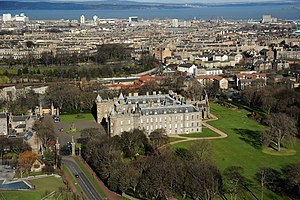
The gardens of the palace extend to some 10 acres (4.0 ha), set within the much larger Holyrood Park. In the 16th century, a privy garden was located to the north of the palace, accessed via a wooden gallery from the north-west tower. This was removed in 1857 when Prince Albert took an interest in the grounds, forming a new carriage drive to the north to avoid the Canongate slums and laying out the garden in its present form.[82]
A small garden building, surviving from the 16th century, is known as Queen Mary's Bath House, although it is not thought to have been used for bathing.
In 1987 the Holyrood Palace and Park were added to the Inventory of Gardens and Designed Landscapes in Scotland.[84]
"Big Royal Dig"
The Palace of Holyroodhouse, along with
See also
- Holyrood (disambiguation)
- Historic Scotland (Executive agency of the Scottish Government responsible for Holyrood Abbey)
References
- ^ "Holyrood". Collins Dictionary. n.d. Retrieved 25 September 2014.
- ^ a b c d Clarke, p. 8.
- ^ a b c d e McWilliam et al. p. 125.
- ^ John G. Dunbar, Scottish Royal Palaces (Tuckwell: East Linton, 1999), pp. 57–59, 178, 198.
- ^ John G. Dunbar, Scottish Royal Palaces (Tuckwell: East Linton, 1999), pp. 57–59, 178, 198.
- ^ Clarke, p. 9.
- ^ Accounts of the Treasurer, vol. 4 (Edinburgh, 1902), pp. 64, 129.
- ^ Lesley Mickel, 'Our Hielandmen': Scots in Court Entertainments at home and abroad 1507–1616', Renaissance Studies, 33:2 (April, 2019), pp. 185–203 at p. 202: Aeneas Mackay, Historie and Cronicles of Scotland, by Robert Lindesay of Pitscottie, vol. 1 (STS: Edinburgh, 1899), p. 244
- ^ Thomas, Andrea, Princelie Majestie (John Donald: Edinburgh, 2005), pp. 96–99.
- ^ Thomas, Andrea, Princelie Majestie (John Donald: Edinburgh, 2005), pp. 100–103.
- ^ a b c McWilliam et al. p. 126.
- ^ a b Clarke, p. 10.
- ^ Rosalind Marshall, Scottish Queens, 1034–1714 (John Donald: Edinburgh, 2003), p. 108.
- ^ Henry Paton, Accounts of the Master of Works, vol. 1 (HMSO: Edinburgh, 1957), p. 298.
- ^ Michael Pearce, 'A French Furniture Maker and the 'Courtly Style' in Sixteenth-Century Scotland’, Regional Furniture, 32 (2018), p. 130.
- ^ Alexandra Johnson, 'Mary Stuart's Inner Chamber at Holyrood', Stephan Hoppe, Krista De Jonge, Stefan Breitling, The Interior as an Embodiment of Power (Heidelberg, 2018), pp. 129–150
- ^ Gordon Donaldson, Accounts of the Collectors of Thirds of Benefices, 1561–1572 (Edinburgh: Scottish History Society, 1949), pp. 146, 156.
- ^ James Beveridge & Gordon Donaldson, Register of the Privy Seal of Scotland, vol. 5:2 (Edinburgh, 1957), pp. 324–325 no. 3361.
- ^ Alma Calderwood, Buik of the Kirk of the Canagait (SRS: Edinburgh, 1961), p. 11.
- ^ a b c Clarke, p. 12.
- ^ Clarke, p. 56.
- ^ Thomson, ed., Diurnal of Occurrents (Edinburgh, 1833) pp. 232, 234.
- ^ Charles Thorpe McInnes, Accounts of the Treasurer: 1574–1580, vol. 13 (Edinburgh, 1978), pp. 162, 166: Henry Paton, ed, Accounts of the Master of Works, vol. 1 (Edinburgh, 1957), pp. 302–307: Calendar State Papers Scotland: 1574–1581, vol. 5 (Edinburgh, 1907), p. 357.
- ^ Exchequer Rolls, 22 (Edinburgh, 1903), 299.
- ^ Edward Cowan, 'Darker vision of the Scottish renaissance', in Renaissance & Reformation in Scotland (Edinburgh, 1983), pp. 132–134.
- ^ Clarke, p. 17.
- ^ a b c d e Clarke, p. 14.
- ^ a b c d McWilliam et al. p. 127.
- ^ Clarke, p. 16.
- ^ a b c McWilliam et al. p. 128.
- ^ Gregg, p. 26
- ^ Clarke, p. 49.
- ^ Clarke, p. 49.
- ^ Clarke, pp. 17–19.
- ^ Clarke, pp. 19–20.
- ^ a b c d Clarke, p. 20.
- ^ The Scotsman (3 September 1842), p. 7.
- ^ Clarke, pp. 22–23, 40–41.
- ^ Maxwell 1906, p. 31.
- ^ Clarke, p. 23.
- ^ Clarke, p. 26.
- ^ Clarke, p. 23.
- ^ Clarke, pp. 27–28.
- ^ a b Clarke, p. 30.
- ^ Clarke, p. 4.
- ^ "Queen's coffin arrives in Edinburgh". BBC News. Retrieved 11 September 2022.
- ^ "St. Giles' Cathedral and its Royal history". Historic Environment Scotland. 12 September 2022. Retrieved 12 September 2022.
- ^ "Zara Phillips and Mike Tindall rock Holyrood House". Daily Mirror. 1 August 2011. Retrieved 18 October 2022.
- ^ "People". Time. New York City. 26 October 1962. Retrieved 17 October 2022.
- ^ "Champagne reception a recipe for disaster". The Herald Scotland. 2 July 1994. Retrieved 3 October 2014.
- ^ "Mikhail Gorbachev visits to Scotland remembered as world pays tribute to Cold War peacemaker". Scottish Daily Express. 31 August 2022. Retrieved 17 October 2022.
- ^ "The Queen greets Nelson Mandela at a banquet held at the Palace of Holyrood". Getty Images. 11 August 2017. Retrieved 13 April 2020.
- ^ Clarke, p. 5.
- ^ "Pope Benedict XVI's speech at Holyrood Palace". The Scotsman. Edinburgh. 16 September 2010. Retrieved 20 May 2011.
- ^ "Canadian PM Justin Trudeau inspires Scots students". BBC News. Retrieved 17 October 2022.
- ^ "1992 Conservative Party General Election Manifesto". The Conservative Party. Archived from the original on 25 June 2002. Retrieved 20 May 2011.
- ^ "Court Circular". The Royal Family. London. 25 October 1997. Retrieved 19 April 2021.
- ^ Heart and Soul 2016.
- ^ "Organisation of the Royal Collection: Management". The Royal Collection. Retrieved 20 May 2011.
- ^ "Queen's official residences to undergo £37m tourism revamp". BBC News. 4 April 2016.
- ^ a b Clarke, p. 28.
- ^ Historic Environment Scotland. "Holyroodhouse, Palace of Holyroodhouse... (Category A Listed Building) (LB28022)". Retrieved 25 March 2019.
- ^ Cruickshank, Dan. "Choosing Britain's Best Buildings". BBC History. Archived from the original on 31 May 2007. Retrieved 3 June 2008.
- ^ "David Morier (1705?–70) – An Incident in the Rebellion of 1745". www.rct.uk. Retrieved 11 November 2021.
- ^ Clarke, p. 31.
- ^ Maxwell 1906, p. 32.
- ^ Clarke, p. 35
- ^ Clarke, p. 36.
- ^ Clarke, p. 38.
- ^ Clarke, pp. 38–39.
- ^ Clarke, p. 40.
- ^ Clarke, p. 41
- ^ a b c Clarke, p. 42.
- ^ Fergus I, King of Scotland (330–305 B.C.) Jacob Jacobsz de Wet II (Haarlem 1641/2 – Amsterdam 1697), Royal Collection Trust
- ^ C. Wemyss, "The Art of Retrospection and the Country Houses of Post-Restoration Scotland" Architectural Heritage XXVI (2015), p. 32.
- ^ Clarke, pp. 49–50.
- ^ a b c d Clarke, p. 45.
- ^ Clarke, p. 47.
- ^ a b Clarke, p. 51.
- ^ Clarke, p. 52.
- ^ Clarke, p. 48.
- ^ Clarke, p. 64.
- ^ a b Clarke, pp. 63–64.
- ^ Historic Environment Scotland. "Palace of Holyroodhouse (GDL00308)". Retrieved 25 March 2019.
- ^ "Seal Matrix". Time Team Big Royal Dig. Channel 4. Archived from the original on 20 June 2008. Retrieved 2 May 2011.
- ^ "Double Tournois". Time Team Big Royal Dig. Channel 4. Archived from the original on 20 June 2008. Retrieved 2 May 2011.
Bibliography
- Clarke, Deborah (2019). The Palace of Holyroodhouse: Official Souvenir Guide. Royal Collection Publications. ISBN 978-1-905686-01-8.
- Dunbar, John (1999). Scottish Royal Palaces. Tuckwell Press. ISBN 1-86232-042-X.
- ISBN 978-0-297-17773-9.
- Gallagher, Dennis (1998). "Holyrood Abbey: the disappearance of a monastery" (PDF). Proceedings of the Society of Antiquaries of Scotland. 128: 1079–1099. S2CID 159975479. Archived from the original(PDF) on 9 May 2012. Retrieved 15 May 2011.
- Gregg, Edward (2001). Queen Anne. Yale University Press. ISBN 0-300-09024-2.
- Jamieson, Fiona (Summer 1994). "The Royal Gardens of the Palace of Holyroodhouse, 1500–1603". Garden History. 22 (1): 18–36. JSTOR 1587000. (JSTOR subscription required)
- Laing, Henry (1867). "Queen Mary's Audience Chamber at Holyroodhouse" (PDF). Proceedings of the Society of Antiquaries of Scotland. 7: 381–384. S2CID 253261913. Archived from the original(PDF) on 23 May 2012. Retrieved 27 September 2011.
- Maxwell, Herbert (1906). Official guide to the abbey-church, palace, and environs of Holyroodhouse: with a historical sketch. William Blackwood and Sons. ISBN 978-0-266224-95-2.
- ISBN 0-14-071068-X.
External links
- Holyrood Palace from Gordon of Rothiemay's map c. 1647
- Palace of Holyroodhouse, The Royal Collection website
- The Royal Residences: Palace of Holyroodhouse, official website of the British Monarchy
- Holyrood House, Royal Palaces by Simon Thurley

